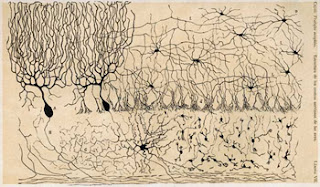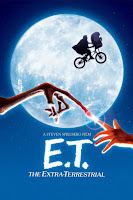Week 7 Neuroscience + Art
As a kind of sequel to last week’s topic, BioTech and Art, this week, we investigated how discoveries and theorizations in Neuroscience influenced art.
Research in neuroscience initially hit the arts with Ramon y
Cajal. As a child, Cajal was entertained by painting and making art, but he
became known as the father of modern neuroscience. He developed the idea behind
Neuron Theory, when he discovered the possibility of reading connection
patterns by simply observing the shapes of neurons. Furthermore, he used his
past experience in art to create beautiful illustrations that were used in his
research.
 The tie between art and neuroscience was also strengthened
through the work of Suzanne Ankor, an artist and theorist, who used FMRI scans
to create optical illusionary images. She used 15 brain scans with superimposed
inkblots and identical butterfly images, with the effect of seemingly different
butterflies appearing.
The tie between art and neuroscience was also strengthened
through the work of Suzanne Ankor, an artist and theorist, who used FMRI scans
to create optical illusionary images. She used 15 brain scans with superimposed
inkblots and identical butterfly images, with the effect of seemingly different
butterflies appearing.  Additionally, one of the more interesting, and more
scientific than the other uses of neuroscience in art is the Brainbow. The
Brainbow refers to the use of fluorescent proteins that were used to
distinguish individual neurons from one another. The resulting images are very colorful
and vivid, to the extent that they won many awards in scientific photography
competitions.
Additionally, one of the more interesting, and more
scientific than the other uses of neuroscience in art is the Brainbow. The
Brainbow refers to the use of fluorescent proteins that were used to
distinguish individual neurons from one another. The resulting images are very colorful
and vivid, to the extent that they won many awards in scientific photography
competitions.
Personally, I find the brainbow to be the most fascinating
fusions of art and science. It is unbelievable that we are able to mark neuron
cells with colored macromolecules to distinguish and create beautiful images.
It also provokes inquiry and thought into how art is such a natural part of
living. The fluorescent proteins are naturally produced by organisms and they
provide vivid colors when introduced to specific environmental conditions. It
makes me realize how our lives as human beings are so tightly bound to artistic
expression.
"Bio Art." Suzanne Anker. N.p., n.d. Web. 21 May 2017.
"Brainbow." Brainbow | Center for Brain Science. N.p., n.d. Web. 21 May 2017.
Jung, Carl Gustav. "The Spiritual Problem of Modern Man." Collected Works of C.G. Jung, Volume 10: Civilization in Transition (n.d.): n. pag. Web.
Frazzetto, Giovanni, and Suzanne Anker. "Neuroculture." Nature Reviews Neuroscience 10.11 (2009): 815-21. Web.
"Santiago Ramon y Cajal: "The Father of Neuroscience"." Brain Connection. N.p., 04 Jan. 2017. Web. 21 May 2017.




Well-written article! I liked your description of the Brain-bow. As you mentioned, it is an example of how the brain itself can be considered art. Nature is often the inspiration for art, but this is a good example of taking some physical biological system literally itself as art.
ReplyDelete